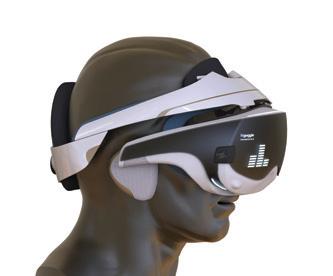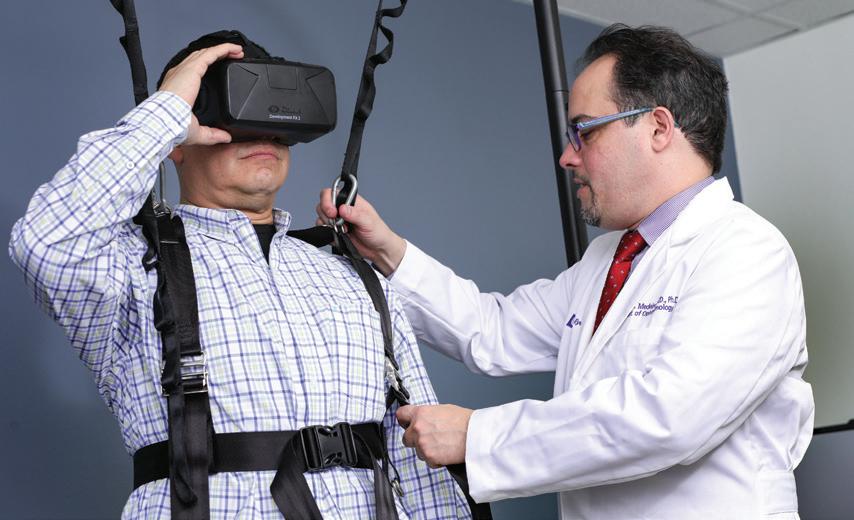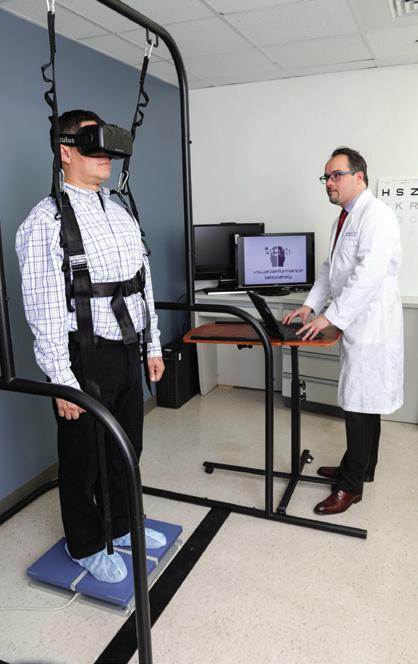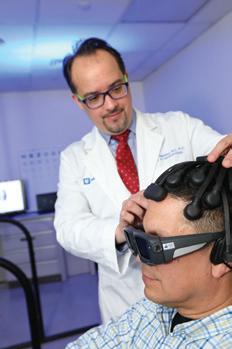
8 minute read
Virtual Reality
Virtually Predictable Duke’s new Visual Performance Lab is using virtual reality and other high-tech gear to predict risk for functional impairments and develop assistive technologies.
A woman with glaucoma is walking down the street when she suddenly loses her balance, trips, and falls. Well, she doesn’t actually fall, since the harness she’s wearing keeps her upright and safe. She removes her virtual reality goggles and steps down from the multi-sensor platform, while lab technicians check the abundant data collected along her “virtual walk through town.” Nearby, a gentleman with macular degeneration is driving through city traffic on a simulator, while data is compiled to assess whether it is still safe for him to drive at this stage of his disease. And across the room, a young boy is engrossed in a video game, unaware that the virtual reality goggles he’s wearing are measuring his brain’s responses to imperceptible peripheral stimuli and assessing his field of view.
DUKE EYE CENTER 2018 It’s all part of the present and future of Duke’s new Visual Performance Laboratory (DVPL), a high-tech research lab created and led by Felipe Medeiros MD, PhD, who joined Duke in August 2017 as Professor of Ophthalmology, Vice Chair for Technology, and Director of Clinical Research. Medeiros, a glaucoma specialist, is a pioneer in the development of innovative methods to diagnose glaucoma and detect its progression, and in the use of innovative technologies for assessment and prevention of functional impairment from the disease. The DVPL will use virtual reality and other high-tech applications to investigate how eye disease impacts patients’ activities of daily living; develop better methods to predict patients who are at a higher risk for those functional impairments; and create assistive technologies to improve the lives of those with impairment. “From a patient’s standpoint, what really matters is whether their disease is going to affect their everyday lives: their ability to drive, read, or find things, or their risk of falling,” Medeiros notes. “If we can predict their individual risk levels, we’ll be able to make better decisions about how aggressively to treat them, and how to help them optimize their quality of life as the disease progresses.” In addition to finding new ways to assess functional performance and understand the mechanisms by which eye diseases like glaucoma and macular degeneration prosecute these impairments, Medeiros and the DVPL are linking the new tests with basic techniques for imaging the eye and traditional visual function assessments, as well as

The nGoggle, developed by Dr. Medeiros, is a device being used to detect visual field defects and brain responses.
subjective assessments via patient questionnaires. These comprehensive datasets will help them build predictive models and testing devices that can be used in clinical practice—or even in the patient’s home.
Applying innovative technologies To achieve these goals, the DVPL embraces virtual reality, simulators and other devices. For instance, Medeiros and his colleagues have: • Devised and patented the nGoggle, a device that integrates electroencephalogram (EEG) and eye tracking to virtual reality (VR) goggles. The nGoggle is able to objectively measure brain waves elicited by visual stimuli presented on the VR goggles, enabling for the first time a portable and objective way for assessing visual function in subjects with eye diseases. The device is being used to detect visual field defects in patients with glaucoma, as well as to investigate brain responses as subjects navigate through a series of scenarios that replicate daily life, like searching for an object in a home, “wayfinding” through a cityscape, or driving a car. While the nGoggle is still in development, its portability, affordability, and ability to transmit data wirelessly offers potential for widespread use, like home-based testing. • Developed an innovative virtual reality paradigm to assess risk of loss of balance and falls in subjects with eye diseases. In this test, subjects use VR goggles while standing on a force platform that measures every little wobble they make in response to visual stimuli designed to perturb their balance, while being secured by a harness system to prevent falls. The postural responses under this environment have been shown to be predictive of risk of falling. • Applied driving simulation to investigate fitness to drive and develop innovative metrics for predicting driving risk in subjects with eye diseases. Based on the simulator studies, they have crafted simple, tablet-based tests that assess visual function parameters most relevant to driving performance. • Built new testing algorithms for diagnosing and monitoring eye diseases, using innovative statistical and artificial intelligence frameworks. One of Medeiros’ algorithms, which combines
Dr. Medeiros adjusts harness for the fall risk assessment.

data from conventional visual field testing with imaging from optical coherence tomography, has been shown to improve diagnosis, staging and detection of progression in glaucoma compared to conventional metrics. The algorithm is being incorporated into commercially available devices and Medeiros is currently exploring ways to integrate additional data for developing a comprehensive model for assessing risk and monitoring disease progression in subjects with glaucoma. • Begun to create game-based testing of visual function, a particularly enticing prospect for practitioners who work with young patients. In this paradigm, subjects play a game while their visual fields are being tested in a fun, imperceptible and objective manner.
Building a multidisciplinary team A generous gift from Durham-based LC Industries has helped bring Medeiros, several members of his lab, and equipment to Duke from his previous post at the University of California, San Diego. (see next page) The gift is also helping Medeiros build a multidisciplinary team needed to do such complex, multifaceted work. The DVPL already includes ophthalmologists, engineers, computer scientists and programmers, basic vision scientists and more—and Medeiros plans to mine the wealth of expertise at Duke and throughout the region to uncover new opportunities for collaboration, and to expand the DVPL’s scope to address even more eye conditions. Although only here for a few months, he has already reached out to colleagues at the Duke Virtual Environment Lab, Pratt School of Engineering, Duke Big Data Initiative, Duke Ophthalmology Biomedical Engineering, and biomedical technology companies and game developers in the Research Triangle to explore potential partnerships. As Duke Ophthalmology’s vice chair for technology, Medeiros is excited to bring opportunities to Duke, like a new partnership with Google Brain to devise methods for diagnosing glaucoma that could be spread worldwide, especially to underserved communities. Medeiros can also envision using artificial intelligence to sift through Duke’s extensive electronic medical records database to develop systems that can recommend treatment options for a current patient based on outcomes from previous patients under similar circumstances. If Medeiros’s plans sound highly ambitious, he’s got the track record to back it up. Although relatively young, he has published over 300 peer-reviewed articles in the literature, which have been cited over 12,000 times. He has recently been named one of the Top 5 Glaucoma Specialists in the World
by the Annals of Library and Information Studies and Expertscape. Medeiros has received over 40 international honors and awards in ophthalmology, including the World Glaucoma Association Award, American Academy of Ophthalmology Senior Achievement Award and the Moacyr Alvaro Gold Medal (the most prestigious award in ophthalmology in Latin America). He will be the recipient of the ARVO’s 2018 Cogan Award, widely regarded as the most prestigious award in ophthalmology for a researcher younger than 45. He is also Chair of the American Glaucoma Society (AGS) Program Committee and is responsible for
coordinating the scientific program of the most important annual meeting of the subspecialty. “We are elated to have Felipe Medeiros join Duke Ophthalmology,” said Department Chair Edward G. Buckley, MD. “He is one of the global drivers of technology applications worldwide, and to have him here at Duke, will undoubtedly reap great benefits, not only for our Duke Eye Center patients, but for people around the world.” Felipe Medeiros, MD, PhD


For decades, LC Industries has been one of the Duke Eye Center’s most generous philanthropic partners. The Durham-based manufacturing, distribution, e-commerce, and retail enterprise, which exists to provide meaningful employment for people who are blind or visually impaired, has played a pivotal role in the Eye Center’s growth as a world-class center for patient care and research. Over the years, strategic philanthropic investments by the company and its CEO, William Hudson, have helped start and build programs and create new spaces to serve patients, like the state-of-the-art Hudson Building on the main Duke campus. This summer, LC Industries made another generous, strategic gift to help Duke recruit clinician-scientist and innovator Felipe Medeiros, MD, PhD, and
Impact

Latest gift from LC Industries helps make the Duke Visual Performance Lab a reality
establish the Duke Visual Performance Laboratory (DVPL). (see story on page 2) “LC Industries’ gift has been essential in allowing us to set up a state-of-the-art laboratory that incorporates innovative technology such as virtual reality, and providing funds to support the human capital that will help us pursue our ambitious goals,” says DVPL Director Medeiros of the $600,000 gift. Philanthropy like LC Industries’ played a major role in attracting Medeiros to Duke. “It is the power of philanthropy that helps clinician-scientists like me advance cutting-edge research that has direct relevance to patients and the community. This type of early support can catapult subsequent funding by public organizations like the NIH and others, which may only consider projects for funding after initial studies have shown feasibility, clinical relevance, and potential impact. Without philanthropy, many projects that have led to impactful changes in the diagnosis and management of diseases would never have taken off.” Both Hudson and LCI President Jeffrey Hawting serve on the Eye Center’s Advisory Board; Hudson is the current board chair. “Technology is making a significant impact on the lives of people who are blind or have low vision,” Hudson says. “The research that Dr. Medeiros is doing in the world of virtual reality is going to take this technology to a whole new level. I can only imagine the positive outcome on the work environment for the hundreds of people who are visually impaired who are employed at LC Industries once they are introduced to this new world. Once again, the Duke University Eye Center has taken the lead in making an impact.”

